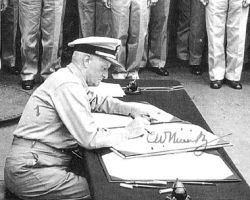“Fifty years ago on this date at Precisely 9 a.m., a group of men representing nine Allied nations and the Japanese government sat across a table on an American battleship and read and signed an instrument.
“This action brought to a close a conflict that had commenced 48 months before.”
The above is the lead paragraph of a story I wrote in this paper commemorating the 50th anniversary of the end of World War II.
In observance of the war, particularly the end of it, Mayor Cheryl Cox and other city officials are hosting a remembrance tomorrow, Aug. 14, at the Veteran’s Center in Chula Vista.
Veterans of the war from many of the branches of the military will congregate at the center, some making speeches, some listening, but all silently ruminating on the events of the surrender and the more important events that led up to the end of hostilities.
What we wrote 15 years ago had much to do with the events leading up to the surrender.
I was in the Washington area a few weeks before the anniversary and had visited the Naval Archives at what was at one time the Naval Gun Factory.
The information that I had obtained from various sources was priceless, not only in the historical value they conveyed but in the homey manner in which much of it was presented.
There were many items of the journal type, that is, someone dictating or writing it out himself, not based on what someone else had said but rather, as he observed and remembered it. The historical facts were there but those were asides and had little to do with what was actually happening. They, however, are the ones that put in the human factor, so to speak, that make us believe that a real live person was present.
Most historians assert that the war was actually over in July. This was approximately two months before the surrender was signed.
The American capture of Iwo Jima and Okinawa and the meeting of the Allied High Command at Potsdam on July 26, 1945, sealed the fate of the Japanese. The two captured Japanese islands were to be used as a base for the many aircraft that would devastate the principal regions of Japan. The Potsdam Declaration laid down an ultimatum: unconditional surrender of all Japanese troops. The declaration concluded with the following: “the alternative for Japan is complete and utter destruction.” Nothing could be more succinct or foreboding than that.
There was no military invasion of Japan but there was an unconditional surrender. The crowning item in the events leading up to the surrender was what occurred on Aug. 7 and 9.
This was the dropping of the two atom bombs on two Japanese cities, Hiroshima and Nagasaki. The damage inflicted was enough to make the Japanese high command agree to the surrender.
There were few folks who knew about the atom bomb. I was on my way back home from the Philippines on a transport when I heard about it.
The only thing I knew about atoms was what I picked up in a high school chemistry class. An atom, I knew, was an infinitesimal item. How could it cause such destruction?
Later we found out.
The surrender, as you know, was signed on the battleship Missouri, named, of course, for the home state of President Harry Truman.
The commanding officer of the Missouri was Capt. Stuard (Sunshine) Murray. I think I spent more time reading his account of that day than anything else.
Among the many incidents that fascinated me was the signing table. Murray related how the British contingent had supplied a table, a fancy hand-carved piece that was nice to look at but much too small to hold the large document that had been sent from Washington. Murray went down to the enlisted mess quarters and commandeered a crew’s mess table and set it up at the surrender site.
He then borrowed a green beige table cloth from the wardroom to cover the table. And this is what the admirals and generals from the many countries leaned on as they signed the instrument that ended the “war of the century.”
After the signing, the mess cook came topside looking for his table.
He probably asked the captain if he was through with the table.
“I have to serve chow,” he probably said. Someone also had remarked that the least Capt. Murray could have done was find a clean table cloth, not one with coffee stains. Now what could be homier than ending a conflict that affected so many people on such a simple note?










